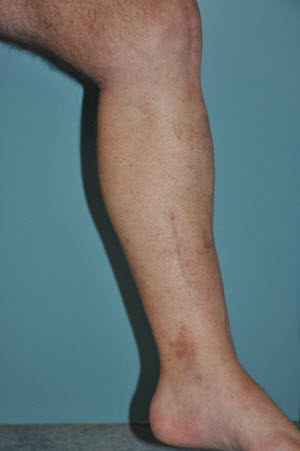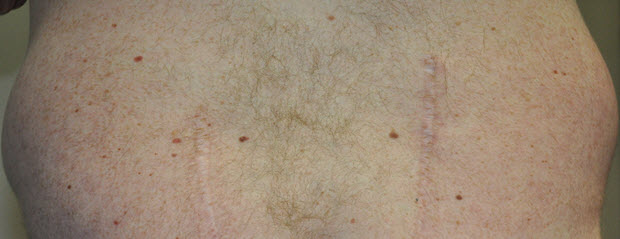Scarring case study - right lower limb
The aim of this case study is to illustrate that an assessment of scarring should provide a clear description of the scars that in turn supports an assessment with reference to all 5 of the TEMSKI criteria and all 10 of the TEMSKI descriptors. Reasoning related to the assessment of multiple scarring must also be included.
Motor Accident Details
42 year old pedestrian struck by a car while attempting to cross a road. Assessment 3 years post motor accident. Clinical appearance of mature scars. No further treatment planned.
Injuries
- Fractures of the left leg (Compound fractures tibia and fibula)
- Neck injury
- Multiple bruises and contusions
Surgery
- Three tibial nails inserted
- Three bone grafts (from sacro-iliac region)
- Removal of tibial nails and fitting of external fixation with plating and bone graft
- Washout and debridement of infected wound



Description
1. Multiple scars left leg
Anterior View: Peri -patellar vertical, irregular scar: 10cm in length and up to 1 cm in width; noticeable colour contrast; claimant able to easily locate scar; trophic changes are evident to touch; no suture marks; usually visible with their usual clothing; contour defect easily visible; minor limitation in the performance of a few ADL’s as is unable to tolerate prolonged kneeling which restricts cleaning and gardening; no treatment is required; and no adherence.
Anterior view: three (external fixation) scars at both the upper and lower end of the leg; All scars 1 cm in diameter; noticeable colour contrast; claimant able to easily locate scars; trophic changes evident to touch; no suture marks; visible with usual clothing; minor contour defect; no effect on ADL’s; no treatment; and some adherence.
Anterior view: scar from fibular head to ankle joint; 29 cm in length and up to 1 cm distally in width; noticeable colour contrast; claimant able to easily locate scar; minimal trophic changes; no suture marks; visible with their usual clothing; no contour defect; no effect on ADLs; no treatment; and no adherence.
Medial view: vertical scar on the medial aspect lower third of the leg; 9 cm in length and 1 cm in width; small transverse element no more than 2 cm; easily identifiable colour contrast; claimant able to easily locate scar; trophic changes evident to touch; no suture marks; usually visible with their usual clothing; minor contour defect; no effect on ADLs; no treatment required; and no adherence.
Medial view: two scars on the upper and lower end of the medial aspect of the leg; upper scar is 2 cm x 1 cm; lower scar 3 cm x 1.5 cm; easily identifiable colour contrast; claimant able to easily locate scars; minimal trophic changes; usually visible with their usual clothing; contour defect easily visible on the upper scar; no effect on ADLs; no treatment; and some adherence.
2. Sacro-iliac region
Two scars over each posterior superior iliac spine; 15cm in length and up to 1 cm in width; noticeable colour contrast; claimant is able to easily locate the scars; trophic changes are evident to touch; staple and suture marks are clearly visible; anatomical location is not usually visible with their usual clothing; no contour defect; no effect on ADL’s; no treatment; and no adherence.
Assessment
- The claimant is conscious of the scars.
- Easily identifiable colour contrast with surrounding skin.
- The claimant is able to easily locate the scars.
- Trophic changes evident to touch.
- Staple and suture marks are visible.
- Anatomic location of scars is usually visible with usual clothing.
- Contour defect easily visible.
- Minor limitation in the performance of a few ADLs in relation to a limited ability to kneel.
- No treatment is required.
- Some adherence.
Determination
Overall, when considered collectively the scars fit in the 3-4% WPI range. The best fit is 4%.
Reasoning
With reference to Chapter 13 of AMA 4 Guides and the Permanent Impairment Guidelines Table 8.1 TEMSKI, using the principle of best fit, several factors warrant the allocation of the 4% rather than 3% category. The total effect of all the scarring on the organ system as a whole has taken account of: the claimant is conscious of the scarring; the easily identifiable colour contrast; the scarring is usually visible with usual clothing; and the presence of both trophic changes and some adherence.
A higher category than 4% is not allocated as the limitation to ADLs is limited to kneeling; there is no restriction in grooming and dressing; exposure to chemical and physical agents do not increase the limitation in ADLs; and there is no requirement for any treatment.
Note: The photos provide an indication of the extent of the scars. Some defects may be not clearly visible. For ease of reference only, descriptors have been addressed according to the order of the TEMSKI.
